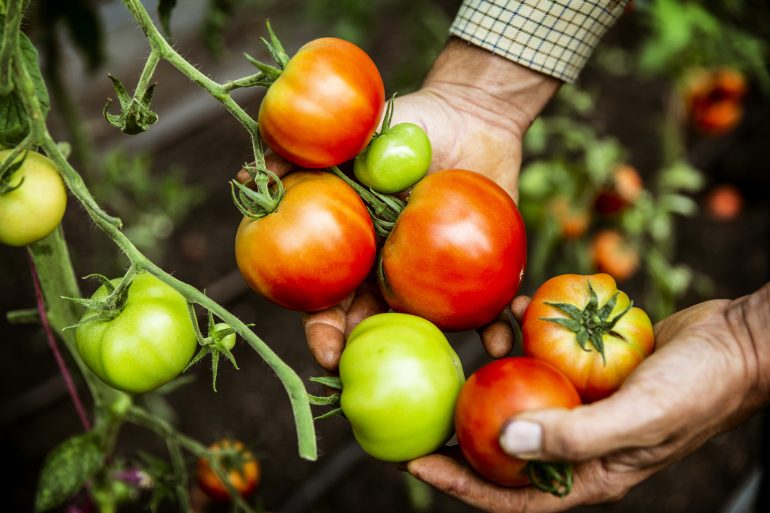Growing your own fruit and veg is a rewarding hobby and whether you’re a green-fingered pro or a novice newbie eager to be a little more self-sufficient, understanding the basics of when to grow tomatoes in the UK is essential for a successful harvest.
It’s believed tomatoes originated from the Andes region of South America and were being cultivated as early as 700 AD. In fact the Aztec word for tomato, is ‘tomatl.’
Strictly speaking, tomatoes are classed as a fruit, but you won’t find them in many desserts! From salads to sandwiches and spaghetti sauce, tomatoes are incredibly versatile. In the UK we eat around half a million tonnes of tomatoes every year, with around a fifth of that number – around 100,000 tonnes – grown here.
Let’s find out when to plant tomatoes in the UK.
When to Sow Tomatoes: UK Guide

Sowing tomato seeds (Credit: FotoDuets via Getty Images)
Timing is key when it comes to knowing when to sow tomato seeds in the UK, as the country’s weather patterns greatly influence the growth and development of tomato plants.
Generally, the best time to start sowing tomato seeds indoors is from late February to early April, depending on your specific location and the variety of tomato you want to grow. This early start gives the seedlings enough time to develop robustly before being transplanted outdoors.
Two Types of Tomato

Bush tomatoes. (Credit: hdagli via Getty Images)
There are two main types of tomatoes – cordon and bush – and each has its own growth habits and cultivation requirements.
Cordon tomatoes, also known as indeterminate tomatoes, are characterised by their vining growth habit. These plants continue to grow and produce fruit throughout the growing season until stopped by frost or disease. Cordon varieties require staking or support, as they can grow quite tall, often reaching over six feet in height. These varieties are ideal for growing in greenhouses, against fences, or on trellises.
Bush tomatoes, on the other hand, are known as determinate tomatoes. They have a more compact, bushy growth habit and do not require staking or pruning. Bush tomatoes grow to a predetermined size, usually around two to four feet in height, and produce all their fruit within a short period. This makes them ideal for container gardening or smaller spaces. Once they have produced their full crop, the plants typically die off.
Growing Tomatoes

A vegetable grower proudly holds tomatoes. (Credit: Mint Images via Getty Images)
When we’re discussing how to grow tomatoes in pots, UK gardeners will know that it’s pretty straightforward! All you need are some 10cm pots, a packet of tomato seeds, a bag of multi-purpose compost and vermiculite (don’t worry, we’ll explain what that is!)
Fill the pots with the compost (leaving a space of 2-3 centimetres below the rim) and then scatter 2-3 seeds on top of the compost and cover it all with vermiculite.
Vermiculite is a natural mineral that expands when heated and is commonly used in gardening and horticulture. It looks like small, light, and airy flakes or pieces and it improves soil aeration, retains moisture, and provides good drainage. When mixed with soil or compost, it creates a better environment for plant roots, making it easier for them to grow and access nutrients.
Then, water the pot and cover it with cling film or a plastic bag to keep the soil moist.
In one to two weeks, seedlings should appear, so take the plastic cover off and move the pot to a light and airy place such as a windowsill, but be careful not to place them in direct sunlight. They should be kept at a temperature of somewhere between 18°C / 64°F and 22°C / 72°F. Small variations in temperature are fine, but they will struggle at anything below 6°C / 43°F.
This is a step-by-step guide to how to grow tomatoes in pots, but there are a few more points to go, including this handy tip…
If your pots are on the windowsill, the plants will naturally bend toward the light so make sure you turn them round every day or two so they grow evenly.
When to Grow Tomatoes in the UK

Home grown tomato vegetables growing on a vine. (Credit: Denisfilm via Getty Images)
So we know when to plant tomatoes in the UK, but what do you do once they’re happily growing on the windowsill?
When the plants get to about 10 cm tall, they’ll be too cramped for a single pot so carefully take out each plant and transfer it to its own pot to allow the roots to grow.
As soon as they’re big enough, they’ll need to finish growing outside, but you should get them used to outside temperatures by taking them outside for a couple of hours a day. This process is known as hardening off. Each day, increase the time they spend outdoors until such time as you can plant them in your beds.
The specific time you decide when to plant tomatoes in the UK outdoors depends on the weather. Generally speaking they should be ready in early summer. In the UK, once tomato plants are transferred outdoors, they should be planted in a sunny, sheltered spot with well-draining soil, ensuring they’re spaced at least 45 cm apart to allow for adequate growth and airflow.
Regular watering, especially during dry spells, is crucial for maintaining soil moisture; additionally, feeding the plants with a high-potash fertiliser once they start flowering will promote healthy fruit development and enhance flavour.
As tomato plants begin to flower, typically in early to mid-summer in the UK, it’s essential to provide steady support, like staking or caging, to accommodate their growth; following the flowering stage, small green fruits will form and gradually swell, ripening to a full, vibrant colour as they mature. You’ll know when to harvest them when they fully ripen and turn ‘tomato red’!












